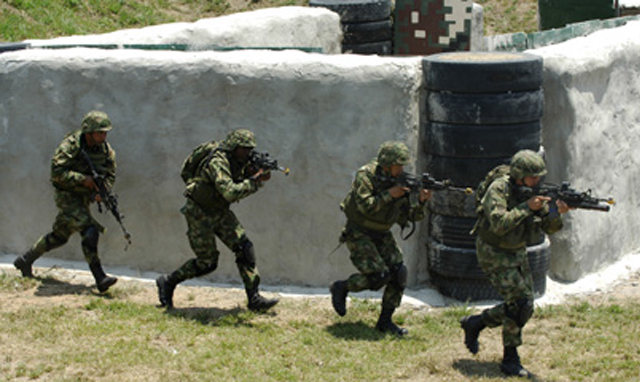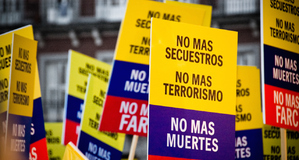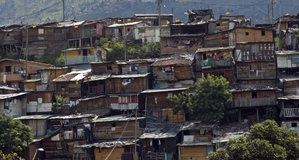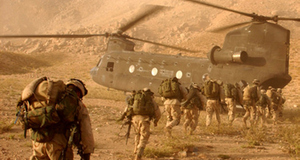|
From Cornell International Affairs Review VOL. 5 NO. 1 Militarization of Aid and its Implications for Colombia
By Ian King
Cornell International Affairs Review
2011, Vol. 5 No. 1 | pg. 2/2 | «
When the transition from military to civilian development fails to occur, the problems of insurgency only worsens. Certain U.N. officials in Afghanistan have recently expressed displeasure with NATO military actions, including the use of the military to provide healthcare and build schools. When the military gets too involved in the economic development of an area, the local people start to see no difference between the civilian and military aid workers. Because armed resistance or insurgency is almost always directed at the military, schools and hospitals are also targeted.29 An insurgency directed at schools and hospitals would certainly be one of the most horrible outcomes of humanitarian aid imaginable, but can be easily avoided by creating a distinction between the different forces administering the aid.

Colombian Special Forces soldiers training for combat.
The amount governmental reform needed in Colombia is enormous, and it cannot come from the military. Prior to US involvement, the Colombian judicial system was not very conducive to prosecuting high profile and high publicity cases, such as drug traffickers or armed resistance groups.
However, with USAID and Department of Justice employees working with the Colombian government to educate and train the judges, attorneys, and clerks in the Colombian judicial system, conviction rates for these types of cases have increased steadily.30 In addition, Colombia has begun to extradite some of its drug traffickers to the United States and other countries with more established justice systems. Under this system, criminals are guaranteed a fair trial without the risk of criminal organizations pressuring witnesses or jurors.31
The mission of the US military is clearly not one of economic development. This should fall to the Treasury and State Departments through programs like USAID. Now that the military has secured certain parts of Colombia from the paramilitaries and guerrillas, the poor farmers, known as campesinos, no longer feel as if they are being forced to grow coca.
With the help of agronomists and developmental economists, communities once known for coca production have shifted towards the production of rice and sugar cane. In these areas, the standard of living and the price of land have also increased significantly thanks to crop substitution and infrastructure improvements.32 Although the military is necessary to provide security in Colombia, no branch of the military can carry out the intricate plans required to rebuild areas like those plagued by coca production in Colombia.
Despite some of the poor outcomes of US policy, Colombia in 2010 is a much better place than Colombia in 1998 in terms of security, human rights, and economic opportunity. The membership of the major armed resistance groups, while still rather high, is considerably lower than at the outset of Plan Colombia. In 2001, two years after the initiation of Plan Colombia, a report estimated that FARC’s membership numbered around 18,000, while AUC had roughly 8,500 troops.33
In 2009, FARC was down to about 9,000, and AUC had as few as 3,000 in its ranks.34 These figures show that the work is not over. However, with all of its flaws, US policy is certainly working. The reductions are just one example that progress is being made. Another such example is the March 2010 conviction in US courts and 20- year sentence given to Jorge Rodriguez, a top FARC commander.35
In 2009, the US and Colombia signed a bilateral Defense Cooperation Agreement, which provides guidelines for US military assistance in the case of disaster or other need for military action in Colombia. Although the US military will receive guaranteed access to a select number of bases in Colombia, no actual US bases will be constructed on Colombian soil. No increase in civilian or military personnel is expected, even though US legislation permits the presence of several hundred more people to serve in Colombia on behalf of the United States government.36 Clearly, the United States has grown sensitive to appearing imperialistic and now seeks to avoid this perception by transferring more responsibility to the local government.
Current procedures must become more adaptable and case-specific before the situation can be put onto a strategy board in Washington. Although there is something to be said for having all members of a service function together, the rigidity of standard operating procedures treats every insurgency in a cookie-cutter fashion, perpetuating the notion that US officials do not consider the culture and values of other countries. Once legislation and manuals change to allow the field commanders more flexibility to avoid supporting corrupt officials in another country, the planning must begin by incorporating methods to review and amend policy as needed.
In the unconventional warfare generated by today’s insurgencies and terrorist groups, officials must be prepared for any imaginable contingency. However, this does not require a rigidly planned response to every particular situation that may arise. Instead, policy makers should explore multiple options in responding to complications while still remaining open to new ideas. Nobody will be able to gauge the real situation from behind a desk, but the thought process must be there, as well as a plan to move the primary focus from security to development.
Once that shift does happen—and it should happen gradually—the military should play only a limited role, maintaining security and providing police and military training to the local agencies. At the same time, civilian workers from USAID and similar agencies should start to work to reform the existing institutions and educate local authorities on human rights, anti-corruption practice, and other democratic values. As the legitimacy of the government solidifies, NGO workers should begin to replace the civilian government workers as the primary administrators of aid.
Because the NGO workers do not officially represent the US government, US control begins to diminish significantly at this time, but this should not be a concern if the economic and governmental reforms have been effective. However, before the US turns complete control back over to the NGOs and the local government, there must be verifiable checkpoints of key values, such as human rights, democratic practices, and transparency in the government. Once the aid operations cease, the US military, as the forerunner in most new military technology, still should share its techniques and continue working with the local military and police forces of what would presumably be a new ally.
This ideal timeline depends entirely on the situation. Either way, militarization of aid is not inherently the enemy. It is necessary to provide other forms of aid and reform crucial to the recovery of a country that is neither secure nor stable. Militarization only becomes a problem when it when it interferes with other forms of aid.
Note: The views here are solely those of the author and not those of the Coast Guard Academy or other branches of the US government.
- Initially, President Pastrana asked foreign leaders such as Bill Clinton for aid to help Colombia end its cycle of underdevelopment and become more in line with the industrialized economies of the world. The plan also provided for some security forces, but Clinton ultimately decided to direct US focus almost exclusively towards security and counterdrug missions. For the full text of Pastrana’s Plan Colombia, see “Plan Colombia: Plan for Peace, Prosperity and Strengthening of the State,” Republic of Colombia, (October 1999).
- “Andean Counterdrug Initiative.” US Department of State Bureau of International Narcotics and Law Enforcement Affairs, September 18, 2007.
- Within the context of this article, military action means anything that involves sending sworn members of the United States Armed Forces into a foreign country. Civilian workers are employees of other areas in the US government used for development, such as the US Agency for International Development (USAID) or the U.N.-State Department combined Civilian Police program (CIVPOL).
- Jones, Seth et. Al. “Securing Tyrants or Fostering Reform? US Internal Security Assistance to Repressive and Transitioning Regimes.” RAND National Security Research Division, 2006, p. iii.
- “First US vessel arrives at Port-Au-Prince.” MSNBC Online, January 13, 2010.
- “US Response to Haiti Earthquake Disaster.” Office of the White House Press Secretary, March 10, 2010.
- “The United States Assists Chile Earthquake Relief.” Embassy of the United States, Santiago, Chile, March 22, 2010.
- Flournoy, Michèle & Pan, Michael. “Dealing with Demons: Justice and Reconciliation.” Washington Quarterly, 25.4 (Autumn 2002), p. 113.9 “Colombia: FARC liberan a rehén.” BBC Mundo, March 29, 2010. (Spanish, translation by the author)
- Romero, Simon. “Colombia Plucks Hostages from Rebels’ Grasp.” The New York Times, July 3, 2008, p. A1.
- Marcella, Gabriel. “Colombia Alert: Plan Colombia: An Interim Assessment.” The Center for Strategic and International Studies’ Hemisphere Focus, 10.2, January 25, 2002.
- Wyler, Liana Sun. “International Drug Control Policy.” Congressional Research Service, June 23, 2008, pp. 4-5.
- “Plan Colombia: Fact Sheet.” Department of State, Bureau of Western Hemisphere Affairs. Washington, D.C., March 28, 2000.
- Jones et al (2006), pp. 161-64.
- Veillette, Connie. “Colombia: Issues for Congress.” Congressional Research Service, January 19, 2005, pp. 2-3.
- “Plan Colombia: Fact Sheet” (2000).
- Bagley, Bruce Michael. “Dateline Drug Wars: Colombia: The Wrong Strategy.” Foreign Policy, Winter 1989-1990, pp. 168-69.
- “Amnesty International’s Position on Plan Colombia.” Amnesty International USA, June 21, 2000.
- Bagley (1989-90), pp. 165-66.
- For a general discussion, see Johnson, Chalmers. Blowback: The Costs and Consequences of American Empire. (New York: Henry Holt and Company, 2004). Some of Johnson’s specific accusations in this paragraph come from pp. 222-23.
- Cited in Wyler (2008), p. 19, as statement of Godson, Roy S. “Violence in Central America,” House Foreign Affairs Committee, Subcommittee on the Western Hemisphere, June 26, 2007.
- Flournoy & Pan (2008), p. 112.
- Zelikow, Philip. “Foreign Policy Engineering: From Theory to Practice and Back Again.” International Security, 18.4 (Spring 1994), p. 144. The entire article runs on pp. 143-71, and is useful in analyzing the lack of foresight in today’s foreign policy.
- Allison describes each of his models in Allison, Graham. “Conceptual Models and the Cuban Missile Crisis,” (1969) in American Foreign Policy: Theoretical Essays, ed. G. John Ikenberry (New York: Pearson Longman, 2005), pp. 402-46. This specific quote comes from p. 416 as a part of the organizational process model.
- “Plan Colombia: Fact Sheet” (2001).
- Veillette (2005), p. 15.
- “Erradicarán manualmente 50 mil hectáreas de coca en 2007.” Office of the Presidency of the Republic of Colombia, January 3, 2007. (Spanish, translation by the author)
- Harvey, Bernard Eugene. “US Military Civic Action in Honduras, 1982-1985: Tactical Success, Strategic Uncertainty.” Army-Air Force Center for Low Intensity Conflict, 1988, p. 48.
- Nordland, Rod. “U.N. Rejects ‘Militarization’ of Afghan Aid.” The New York Times, February 17, 2010.
- “Andean Counterdrug Initiative” (2007).
- Wyler (2008), p. 16.
- Forero, Juan. “Colombian Farmers Get Broad Incentives to Forgo Coca Crops.” Washington Post, May 22, 2009.
- Cited in Solaún, Mauricio. “US Interventions in Latin America: Plan Colombia.” University of Illinois, Urbana-Champaign’s Program in Arms Control, Disarmament, and International Security, April 24, 2002, p. 14.
- Cited in Saab, Bilal Y. and Taylor, Alexandra W. “Criminality and Armed Groups: A Comparative Study of FARC and Paramilitary Groups in Colombia,” Studies in Conflict & Terrorism, 32.6 (2009), pp. 459, 463.
- “EE.UU.: condenan a ex rebelde a prisión.” BBC Mundo, March 19, 2010. (Spanish, translation by the author)
- “US-Colombia Defense Cooperation Agreement.” US Department of State, Office of the Spokesman, August 18, 2009
Photos courtesy of:
- http://upload.wikimedia.org/wikipedia/commons/a/a4/Special_Forces_Colombia.jpg
- http://upload.wikimedia.org/wikipedia/commons/3/32/Colpolwpowell.png
- http://upload.wikimedia.org/wikipedia/commons/7/72/Donald_Rumsfeld_Andres_Pastrana_Pentagon_Feb_2001_010226-D- 9880W-030.jpg
Endnotes
- Initially, President Pastrana asked foreign leaders such as Bill Clinton for aid to help Colombia end its cycle of underdevelopment and become more in line with the industrialized economies of the world. The plan also provided for some security forces, but Clinton ultimately decided to direct US focus almost exclusively towards security and counterdrug missions. For the full text of Pastrana’s Plan Colombia, see “Plan Colombia: Plan for Peace, Prosperity and Strengthening of the State,” Republic of Colombia, (October 1999).
- “Andean Counterdrug Initiative.” US Department of State Bureau of International Narcotics and Law Enforcement Affairs, September 18, 2007.
- Within the context of this article, military action means anything that involves sending sworn members of the United States Armed Forces into a foreign country. Civilian workers are employees of other areas in the US government used for development, such as the US Agency for International Development (USAID) or the U.N.-State Department combined Civilian Police program (CIVPOL).
- Jones, Seth et. Al. “Securing Tyrants or Fostering Reform? US Internal Security Assistance to Repressive and Transitioning Regimes.” RAND National Security Research Division, 2006, p. iii.
- “First US vessel arrives at Port-Au-Prince.” MSNBC Online, January 13, 2010.
- “US Response to Haiti Earthquake Disaster.” Office of the White House Press Secretary, March 10, 2010.
- “The United States Assists Chile Earthquake Relief.” Embassy of the United States, Santiago, Chile, March 22, 2010.
- Flournoy, Michèle & Pan, Michael. “Dealing with Demons: Justice and Reconciliation.” Washington Quarterly, 25.4 (Autumn 2002), p. 113.9 “Colombia: FARC liberan a rehén.” BBC Mundo, March 29, 2010. (Spanish, translation by the author)
- Romero, Simon. “Colombia Plucks Hostages from Rebels’ Grasp.” The New York Times, July 3, 2008, p. A1.
- Marcella, Gabriel. “Colombia Alert: Plan Colombia: An Interim Assessment.” The Center for Strategic and International Studies’ Hemisphere Focus, 10.2, January 25, 2002.
- Wyler, Liana Sun. “International Drug Control Policy.” Congressional Research Service, June 23, 2008, pp. 4-5.
- “Plan Colombia: Fact Sheet.” Department of State, Bureau of Western Hemisphere Affairs. Washington, D.C., March 28, 2000.
- Jones et al (2006), pp. 161-64.
- Veillette, Connie. “Colombia: Issues for Congress.” Congressional Research Service, January 19, 2005, pp. 2-3.
- “Plan Colombia: Fact Sheet” (2000).
- Bagley, Bruce Michael. “Dateline Drug Wars: Colombia: The Wrong Strategy.” Foreign Policy, Winter 1989-1990, pp. 168-69.
- “Amnesty International’s Position on Plan Colombia.” Amnesty International USA, June 21, 2000.
- Bagley (1989-90), pp. 165-66.
- For a general discussion, see Johnson, Chalmers. Blowback: The Costs and Consequences of American Empire. (New York: Henry Holt and Company, 2004). Some of Johnson’s specific accusations in this paragraph come from pp. 222-23.
- Cited in Wyler (2008), p. 19, as statement of Godson, Roy S. “Violence in Central America,” House Foreign Affairs Committee, Subcommittee on the Western Hemisphere, June 26, 2007.
- Flournoy & Pan (2008), p. 112.
- Zelikow, Philip. “Foreign Policy Engineering: From Theory to Practice and Back Again.” International Security, 18.4 (Spring 1994), p. 144. The entire article runs on pp. 143-71, and is useful in analyzing the lack of foresight in today’s foreign policy.
- Allison describes each of his models in Allison, Graham. “Conceptual Models and the Cuban Missile Crisis,” (1969) in American Foreign Policy: Theoretical Essays, ed. G. John Ikenberry (New York: Pearson Longman, 2005), pp. 402-46. This specific quote comes from p. 416 as a part of the organizational process model.
- “Plan Colombia: Fact Sheet” (2001).
- Veillette (2005), p. 15.
- “Erradicarán manualmente 50 mil hectáreas de coca en 2007.” Office of the Presidency of the Republic of Colombia, January 3, 2007. (Spanish, translation by the author)
- Harvey, Bernard Eugene. “US Military Civic Action in Honduras, 1982-1985: Tactical Success, Strategic Uncertainty.” Army-Air Force Center for Low Intensity Conflict, 1988, p. 48.
- Nordland, Rod. “U.N. Rejects ‘Militarization’ of Afghan Aid.” The New York Times, February 17, 2010.
- “Andean Counterdrug Initiative” (2007).
- Wyler (2008), p. 16.
- Forero, Juan. “Colombian Farmers Get Broad Incentives to Forgo Coca Crops.” Washington Post, May 22, 2009.
- Cited in Solaún, Mauricio. “US Interventions in Latin America: Plan Colombia.” University of Illinois, Urbana-Champaign’s Program in Arms Control, Disarmament, and International Security, April 24, 2002, p. 14.
- Cited in Saab, Bilal Y. and Taylor, Alexandra W. “Criminality and Armed Groups: A Comparative Study of FARC and Paramilitary Groups in Colombia,” Studies in Conflict & Terrorism, 32.6 (2009), pp. 459, 463.
- “EE.UU.: condenan a ex rebelde a prisión.” BBC Mundo, March 19, 2010. (Spanish, translation by the author)
- “US-Colombia Defense Cooperation Agreement.” US Department of State, Office of the Spokesman, August 18, 2009
Photos courtesy of:
- http://upload.wikimedia.org/wikipedia/commons/a/a4/Special_Forces_Colombia.jpg
- http://upload.wikimedia.org/wikipedia/commons/3/32/Colpolwpowell.png
- http://upload.wikimedia.org/wikipedia/commons/7/72/Donald_Rumsfeld_Andres_Pastrana_Pentagon_Feb_2001_010226-D- 9880W-030.jpg
Suggested Reading from Inquiries Journal
In recent years the United States has undertaken daunting activities in fighting two overarching wars against intangible enemies across many borders. The war on drugs and the war on terror have severed many national ties, even as globalization continues. Only a few countries, however, have experienced the full devastation of both... MORE»
Colombia has had the longest internal armed conflict in the Western Hemisphere, which has delayed the development of a true democratic system where the government protects individual rights and liberties [1]. The prolonged conflict is a consequence of opposing political ideologies, tremendous inequality, tension between the... MORE»
Since 2000, the United States (U.S.) has devoted approximately 4.7 billion dollars in foreign aid to Colombia (Isacson 2006:1) with the dual aims of resolving Colombia’s internal conflict and of curbing the country’s role in the international drug trade (USAID 2000). Among the more famous elements of Plan Colombia,... MORE»
When should the United States intervene militarily in weak countries? This is a topic of pressing international concern because the United States keeps intervening in weak countries. We are currently involved indirectly in Libya and very deeply in Afghanistan, as well as still being involved to some extent in Iraq. We have a propensity... MORE»
Latest in Political Science
2022, Vol. 14 No. 09
This interdisciplinary paper investigates the shortfalls and obstacles to success currently facing the climate movement, examining issues represented by the disconnect between policy and electoral politics, the hypocrisy and blatant indifference... Read Article »
2022, Vol. 14 No. 06
Two of the most prevalent protest movements in recent history were the Black Lives Matter and the #StopTheSteal movements. While there are many differences between the two, one of the most prevalent is their use of violence. Whereas the BLM movement... Read Article »
2022, Vol. 14 No. 05
Strong linkages between autocrats and the military are often seen as a necessary condition for authoritarian regime survival in the face of uprising. The Arab Spring of 2011 supports this contention: the armed forces in Libya and Syria suppressed... Read Article »
2022, Vol. 14 No. 04
During the summer of 2020, two fatal shootings occurred following Black Lives Matter protests. The first event involved Kyle Rittenhouse in Kenosha, Wisconsin, and the second Michael Reinoehl in Portland, Oregon. Two shootings, each committed by... Read Article »
2022, Vol. 14 No. 02
In popular international relations (IR) theory, knowledge production is often dismissed as an objective process between the researcher and the empirical world. This article rejects this notion and contends that the process of knowledge production... Read Article »
2022, Vol. 14 No. 01
This article explores the political relationship between nation-building, ethnicity, and democracy in the context of Ethiopia. It traces Ethiopia's poltical history, explores the consequential role ethnicity has played in the formation of the modern... Read Article »
2022, Vol. 14 No. 01
The study examines the degree to which Xi Jinping has brought about a strategic shift to the Chinese outward investment pattern and how this may present significant political leverage and military advantages for China in the Indian Ocean Region (... Read Article »
|





















